Ashley Bryan
Books
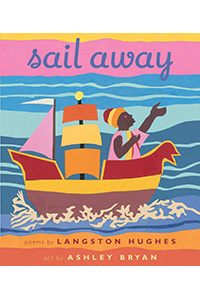
Sail Away, Poems by Langston Hughes (2015)
Ashely’s newest release is a collection of Langston Hughes’ poems of water and the sea. Ashley’s love of Langston Hughes’ poetry stems from his desire to seek and celebrate the child within us all. “Langston Hughes has a way of summing up feelings, so that the youngest child can understand.”
Ashley’s collage illustrations for this book have been compared to works by Matisse and Jacob Lawrence in issue 12 of the quarterly Canadian art journal, Kolaj (2015), by art historian, Dan Kany.
Kany observes, “Bryan’s images in Sail Away…follow rhythms and visual paths to develop into [complex] narrative structures.”

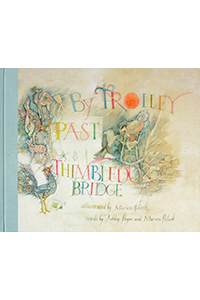
By Trolley Past Thimbleton Bridge (author), illustrated by Marvin Bileck (Alazar Press), 2015
This extraordinary labor of love, thirty years in the making, was illustrated by Ashley’s dear friend, Marvin (Buddy) Bileck—originally intended for a manuscript by Virginia Woolf. When Bileck’s intensely intricate drawings took longer than the publisher’s deadline allowed, the project was withdrawn, and Ashley convinced his friend to keep going, himself writing a new, whimsical poem for Buddy to incorporate into the brilliant, playful drawings. It took another thirty years for this book to reach its audience—finally—thanks to the talent and vision of Ashley’s friends at Alazar Press. Note: Bileck’s drawings are so detailed and playful, they are best enjoyed with a magnifying glass!

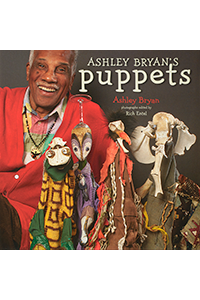
Ashley Bryan’s Puppets
Ashley himself is amazed by his puppets. “Each one is a miracle,” he claims. “I don’t know how they happen!”
How they happen is that he creates them from objects he finds on the beaches of his beloved island home—bones, shells, flotsam and jetsam. The objects suggest forms to him, and the puppets emerge from his hands, reminiscent of grand traditions of European pageantry, each sporting a symbolic African name.
Ashley’s friend, Rich Entel, himself an accomplished sculptor, designed the exquisitely photographed portraits of the puppets, each brought to life by Ashley’s original, playful and poignant poems.

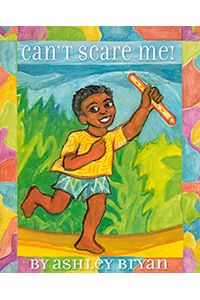
Can’t Scare Me
Ashley developed this story from an Afro-Caribbean tale, adapted from an ethnographic linguistic translation he uncovered through his extensive research. He created the tempera-painted illustrations in a continuous bordered storyboard, that could almost be presented as a scroll.
In this iconic story, a little boy disobeys his grandmother’s warnings, and he ventures into the forest where he is sure to encounter the dreaded two-headed giant who eats children. In Ashley’s hilarious twist, this fearless boy is ultimately terrified of the giant’s terrible singing, when the giant tries to sing the boy’s own catchy chant. The story is told in rhythms that adults and children alike cannot resist.


Who Built the Stable
Ashley wrote this poem in a moment of inspiration during one of his many trips to Africa. He then carefully developed gorgeous tempera paintings to accompany the text, finding further inspiration for the structure of the stable at home on his island in Maine, when a timber frame home was raised by the community. Who Built the Stable is a beautiful, ecumenical nativity story as seen through the eyes of a child. The son of a carpenter builds a stable for a weary family when there is no room for them at the inn. This remarkable boy and his simple gesture of hospitality and generosity reminds us of the season’s universal messages.

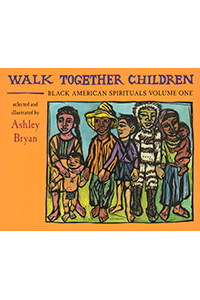
Black American Spirituals Vol 1 (Marcel Dekker),1974, (Atheneum), 1981; (Alazar Press), 2012
Ashley Bryan hand-cut the linoleum block prints for the original 1974 publication of this collection of negro spirituals, as well as the staff and notes to aid any child on a C-recorder who might attempt to play them. This collection, with a new color cover and forward, is lovingly brought back by Ashley’s friends at Alazar Press, along with its companion volume: I’m Going to Sing—a gorgeous and important testament to the spirit of freedom that resided in the African-American slaves who artfully created and preserved these classic songs.


I’m Going to Sing, Black American Spirituals, Vol 2 (Atheneum),1982; (Alazar Press), 2012
Ashley hand-cut the linoleum block prints for the original 1982 publication of this collection of Negro spirituals, as well as the staff and notes to aid any child on a C-recorder who might attempt to play them. This collection, with a new color cover and forward, is lovingly brought back by Ashley’s friends at Alazar Press, along with its companion volume: Walk Together Children—a gorgeous and important testament to the spirit of freedom that resided in the African-American slaves who artfully created and preserved these classic songs.

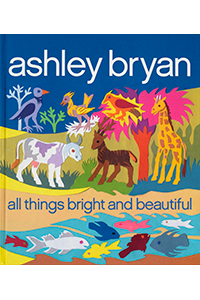
All Things Bright and Beautiful (illustrator), by Cecil F. Alexander (2010)
Ashley’s colorful collage illustrations bring to life this beautiful hymn made famous by nineteenth-century poet, Cecil F. Alexander, who paired it with a seventeenth century melody. Ashley’s lively collage images are set in sea, sky and earth, depicting plants, animals and people of every type and color. His elemental creations are all beautiful and harmonious testaments to the interconnectedness of God’s creations.

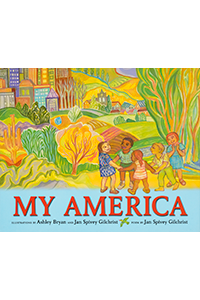
My America (co-illustrator), by Jan Spivey Gilchrist (HarperCollins), 2007
Ashley’s friend, fellow writer/illustrator and Coretta Scott King Award Winner, Jan Spivey Gilchrist, wrote this exquisite poem to celebrate the beauty and strength of America’s natural resources, including its diverse peoples. Ashley and Jan illustrated alternate lines of the poem, to create a beautiful compilation of their complementing visions and styles.


Let it Shine, Three Favorite Spirituals (2007)
Ashley’s brief author's note explains the importance of the Spirituals in the annals of American history; it is imperative to teach that these iconic songs originated from the African-American slaves.
This book introduces the Spirituals to young children with a fun, spashy presentation. Ashley’s love of the Spirituals “shines” through his exquisite, colorful, paper-cut collage images, illustrating three popular spirituals: Let it Shine, When the Saints Go Marching In, and He’s Got the Whole World in His Hands.

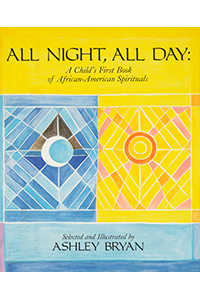
All Night, All Day, A Child’s First Book of African-American Spirituals (2004)
The original 1991 publication of this title won a 1992 Coretta Scott King Honor for its full-spread, colorful, tempera painted Illustrations that resemble Ashley’s jewel-like stained-glass panels. The book also includes musical notation and full piano and guitar accompaniment to some of the most well known and loved African and African-American Spirituals.
“Whenever I present to any audience anywhere in the world,” Ashley says, “these songs are known.” But here, in America, when I ask, ‘Who knows a Negro spiritual?’ Nobody responds. When I ask, ‘Who knows a song of the Black African slaves who came to America?” Nobody raises a hand. “But when I start singing, ‘He’s got the whole world in his hands…’ they sing me down. ‘This little light of mine…’ Everyone’s up and singing.”
Ashley has made it part of his life’s work to educate the American public as to the origins of these “traditional American songs”—“a gift from the African slaves whose only outlet for freedom was through their song.”

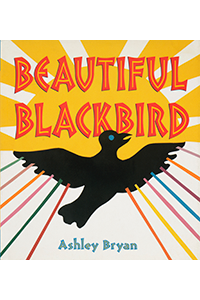
Beautiful Blackbird (2003)
Beautiful Blackbird is perhaps Ashley’s most famous book, and deservedly so. It won the 2004 Corretta Scott King Award for its striking collage illustrations, and it has been reprinted countless times in many languages—a staple in every classroom and children’s library. It is a book about tolerance, celebration of diversity and so much more.
There is a reason the Ashley Bryan Center chose the Beautiful Blackbird as its emblematic symbol—and it is not just because Ashley is African-American, or because Blackbird is an artist.
Blackbird represents the best qualities of Ashley Bryan’s character that we hope to emulate as an organization. Like Ashley, Blackbird is kind and welcoming to all; he is generous with his knowledge and creativity. In the story, Blackbird brings together community, while he celebrates individuality—emphasizing inclusion and self-worth. Even as Blackbird shares his gifts, he cautions, “Just remember, whatever I do, I’ll be me and you’ll be you.”


Ashley Bryan’s ABC of African American Poetry (2001)
This beautiful collection, with its inspired illustrations in tempera and gauche, is more a child’s introduction to the beauty and charm of poetry and art—than it is an alphabet book, per se.
Ashley introduces his favorite African American poets, explaining in his introduction how he used "only the lines of the poems which inspired the images and capitalizing the alphabet letter wherever it occurred in those lines.”
Yet, in another way, this book is truly an “ABC” book, in that for many, it is a primer, representing a first anthology of a rich, cultural collection that is so accessible, it is easily loved by both adults and children everywhere.


How God Fix Jonah (illustrator), by Lorenz Graham (Boyds Mills Press), 2000
Author Lorenz Graham’s collection of biblical tales is written in West-African dialect, with the rhythm, cadence and simple beauty found in a timeless oral tradition. Originally published in 1946, this new addition, with its original preface by Dr. W.E.B. Du Bois, includes two new stories and full-page block print illustrations by Ashley.

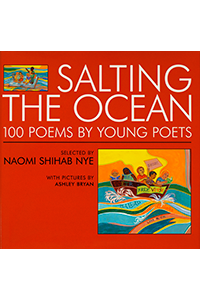
Salting the Ocean, 100 Poems by Young Poets (illus), by Naomi Shihab Nye (Greenwillow Books), 2000
Poet Naomi Shahab Nye compiled this anthology of student poetry from the many workshops she gave over decades to students of all ages. Each section is punctuated by vibrant color illustrations by Ashley. This book is a wonderful tool—both for teaching elements of poetry, as well as for demonstrating the power of its capacity to provide fulfillment and enjoyment

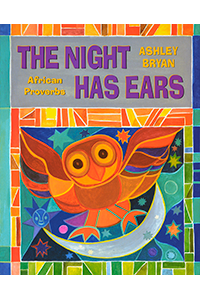
The Night Has Ears, African Proverbs (1999)
Ashley loves proverbs. As a young child, his mother would recite proverbs, apply their universal wisdom to any situation that would arise and even embroider the catchy sayings on samplers that decorated the house. Imagine Ashley’s delight when he discovered that around the world, proverbs are used everywhere to describe life’s quirky moments and to teach valuable lessons.
In this book, Ashley has fun sharing 26 proverbs he uncovered and illustrated from his extensive research of proverbs from across Africa—all amusing and thought provoking—as are his playful interpretive tempera painted illustrations. Proverbs like the Kpelle saying: “As a crab walks, so walks its children” are strangely familiar and universal.

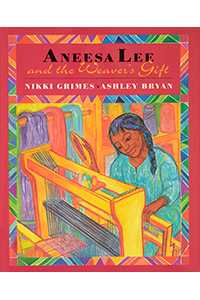
Aneesa Lee and the Weaver’s Gift (illustrator), by Nikki Grimes (Harper Collins), 1999
Nikki Grimes’ collection of thirteen poems are “woven” together through the metaphor of Aneesa’s loom. Aneesa’s passion for weaving gives voice to her multi-racial heritage, family, culture, tradition, and her place in the world. Ashley’s vibrant tempera illustrations express their own tapestry of color and emotion.

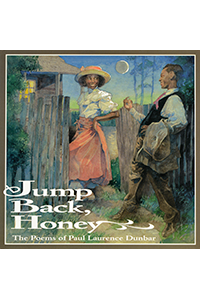
Jump Back, Honey: The Poems of Paul Laurence Dunbar (editor and co-author of introduction; co-illustrator with Brian Pickney and 4 other illustrators), (Disney-Hyperion), 1999
This celebration of early twentieth century poet Paul Laurence Dunbar is brought to life by Ashley and five of his distinguished colleagues: Carole Byard, Jan Spivey Gilchrist, Brian Pinkney, Jerry Pinkney and Faith Ringgold. In the afterward, each illustrator writes a poignant tribute to the ongoing influence and contribution of Dunbar’s poetry to African-American culture.

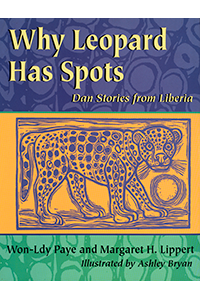
Why Leopard Has Spots, Dan Stories from Liberia, (illustrator), by Won-Ldy Paye and Margaret H. Lippert (Fulcrum Publishing), 1999
This is an extraordinary collection of traditional tales from Liberia brought to the page with rich, colloquial language. In an historic collaboration, educator and storyteller Margaret Lippert worked with Won-Ldy Paye, a “tlo ker mehn" from the Dan ethnic group, who grew up in a family whose traditional role was storytelling performance for the community. Pay’s six delightful tales are dramatically illustrated by Ashley’s exquisite linoleum prints.

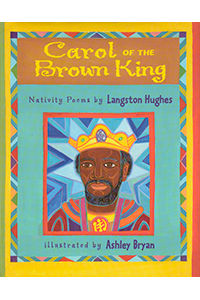
Carol of the Brown King, Nativity Poems by Langston Hughes (1998)
Ashley’s love of Langston Hughes’ poetry led him to five short children’s poems about Christmas by Langston Hughes and one that Hughes had translated from Spanish to English “from a Puerto Rican Christmas card.” Ashley illustrated these poems with bright tempera and gouache illustrations, evoking joy through his colorful, bold forms.
Ashley says that what he most loves about Langston Hughes is his “way of summing up feelings, so that the youngest child can understand.” This book is a testament to that talent.

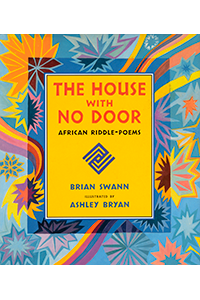
The House with No Door: African Riddle-Poems (illustrator), by Brian Swann (HMH Books for Young Readers), 1998
Brian Swann, a scholar who collects riddle poems from around the world, presents twenty-two riddle poems of African origin. Ashley’s lovely, colorful paintings offer gentle visual hints to children pondering the mystery of the ambiguous sentence puzzles, such as: “I stepped on it./It stepped on me (“water”).”

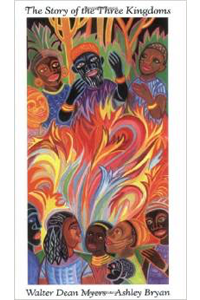
The Story of the Three Kingdoms (illustrator), by Walter Dean Myers (HarperCollins), 1997 (due to be re-released soon by Scholastic)
In this original fable by Walter Dean Myers, the world is divided into three kingdoms: The forest ruled by Elephant, the sea ruled by Shark, and the sky ruled by Hawk. Ashley’s dramatic colors and forms perfectly complement the powerful rhythm and cadence of Myers’ story. In which the quarrelsome trio are outwitted by the intimidated People, who learn their tactics through the power of storytelling and the wisdom it bestows.

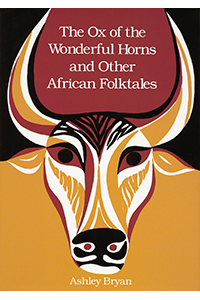
The Ox of the Wonderful Horns and Other African Folktales (1993)
Originally published in 1971, these are five African tales Ashley discovered and resurrected from his extensive research of ethnographic and linguistic studies of African stories. Ashley’s challenge was to bring the stilted language of the linguists’ narration back to an oral tradition through rhythm and poetic verses.
The anthology contains: Ananse the Spider in Search of a Fool (Akan-Ashanti); Frog and His Two Wives (Angola); Elephant and Frog Go Courting (Angola); Tortoise, Hare, and the Sweet Potatoes (South Africa) and The Ox of the Wonderful Horns (Kaffir).
Ashley’s black and white and two-color plus black tempura illustrations evoke African wood block motifs that suggest the ochres and reds of African clay dyes and African textile designs.


What a Wonderful World (illus), by George David Weiss and Bob Thiele (1995)
Ashley’s colorful illustrations accompany the beautiful lyrics of hope and love, by George David Weiss and Bob Thiele, made famous by Louis “Satchmo” Armstrong. Ashley brings the song alive through vivid tempera painted images of children from all cultural backgrounds performing a puppet show full of wonder.


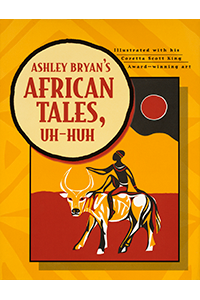
Ashley Bryan’s African Tales, Uh Huh (1998)
This is a collection of fourteen of Ashley’s favorite tales, many of which have been previously published in The Ox of the Wonderful Horns; Beat the Story-Drum, Pum-Pum (Coretta Scott King Award for Illustration); and Lion and the Ostrich Chicks (Coretta Scott King Honor Book). Ashley brings the oral traditions from across Africa back to life through the rhythms of his prose, his bold lines and the African-inspired hues (black, white, ochre and red) of his illustrations.

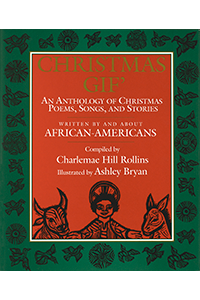
Christmas Gif’, An Anthology of Christmas Poems, Songs and Stories Written by and About African-Americans (illustrator), by Charemae Rollins (HarperCollins), 1993
This compilation of stories, poems, memories, spirituals and recipes by and about African-Americans recreates the landmark anthology first compiled three decades prior to the publication of this edition. This new edition includes over five dozen linoleum block print illustrations by Ashley. Librarian Charlemae Hill Rollins originally compiled the material for this collection as part of her ongoing mission to celebrate African-American traditions and to educate young, black children about the history and richness of their cultural heritage.

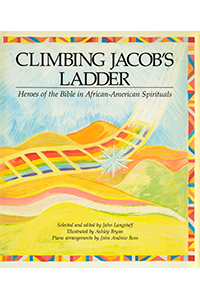
Climbing Jacob’s Ladder (illus), by John Langstaff (1991)
John Langstaff, of Christmas Revels fame, collaborated with Ashley to create this book of African-American spirituals based on nine biblical heroes and prophets of the Old Testament. The songs are accompanied by brief biographical stories, Ashley’s exciting tempera paintings and Andrew Ross’ smart piano arrangements.

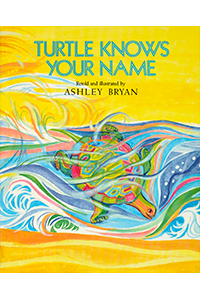
Turtle Knows Your Name (1989)
Can you say, “Upsilimana Tumpalerado”? That is the name of the little boy in this catchy, rhythmic West Indian folktale about a little boy and his grandmother, who learn, through a hilarious journey, to honor their identities and celebrate their self-worth. In an ultimate celebration of color, joy, diversity and oh! so much more, this book delights both adults and children with its exquisite tempera painted illustrations and fun repeating rhymes.


Sh-Ko and his Eight Wicked Brothers (illustrated by Fumio Yoshimura), 1988
Ashley met Japanese sculptor Fumio Yoshimura while the two artists were teaching together at Dartmouth College. After hearing Fumio tell this traditional Japanese folktale, Ashley wrote a retelling of the tale and encouraged his friend to illustrate the story in traditional Japanese ink-wash. In this classic story, Sh-ko is not valued by his eight older wicked brothers, who all think him to be stupid and ugly. But Sh-ko is rewarded for having a kind heart and a desire to help others. Ashley’s beautiful rendition of the universal tale teaches that a good character will always prevail.

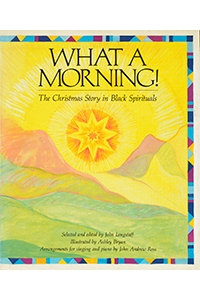
What a Morning,The Christmas Story in Black Spirituals, by John Langstaff (1987)
John Langstaff, of Christmas Revels fame selected these five spirituals, beautifully arranged for singing, guitar and piano, by John Andrew Ross.
Ashley’s bright illustrations tell the nativity story in simple, chronological order, tying the story to African-American themes. With universally recognizable images of a Black holy family and multi-racial wise men and shepherds, Ashley’s luminous paintings engage the viewer in a feeling of immense joy, harmony and peace.

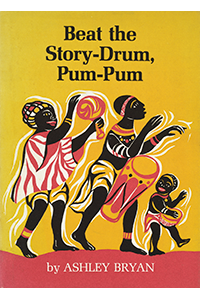
Beat the Story-Drum, Pum-Pum (1987)
Ashley’s retelling of these five Nigerian tales is as rhythmic as the beating of the story drum itself. His black and white and two-color plus black tempura illustrations evoke African wood-block motifs that suggest the ochres and reds of African clay dyes and African textile designs.
You may find that the animals of these stories are a lot like some people you know, and the one story with human characters explores a problem we all have, in one way or another. Most folktales give us a picture of ourselves at our best and worst, but these African stories seem to get at the heart of being human with more force and more humor than most.

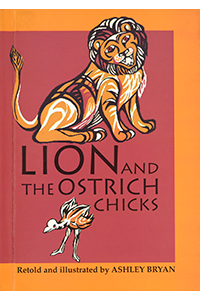
Lion and the Ostrich Chicks and Other African Folk Poems (1986)
Ashley collected these four tales from different regions of Africa (Masai, Bushman, Angola and Hausa)—all of them teaching important universal lessons about life, and about overcoming obstacles and fears. Three of the stories are animal trickster tales, while in the fourth, a boy learns to be cautious when playing with superhuman forces. Ashley’s black and white and two-color plus black tempura illustrations evoke African-wood block motifs that suggest the ochres and reds of African clay dyes and African textile designs.

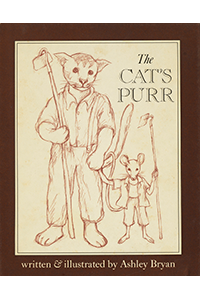
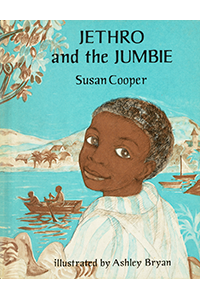
Jethro and the Jumbie (illustrator), by Susan Cooper, 1979
Ashley illustrated this endearing story with images inspired by visits to his family’s native Antigua. His friend, author Susan Cooper, wrote this story in the dialect of her beloved British Virgin Islands.
In the story, Jethro is angry at his older brother for not keeping his promise to take him fishing on his eighth birthday. Jethro meets a shape-shifting jumbie spirit who helps him change his brother’s mind.


Jim Flying High (illustrator), by Mari Evans (Doubleday), 1979
Jim is a flying fish whose pride prevents him from admitting defeat when he accidentally lands in a tree and nearly dries up. Mari Evans’ story, humorously told in poetic prose and cheerfully illustrated by Ashley’s colorful paintings, is a reminder to children that it is OK to seek help. Perhaps more importantly, the tale reminds adults that it is often prudent to help stubborn, proud youngsters find “a way out” when they’ve backed themselves in a corner and need to save face.

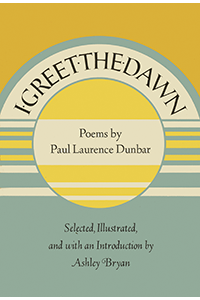
I Greet the Dawn (illustrator), poems by Paul Laurence Dunbar (1978)
Paul Laurence Dunbar (1872-1906) was one of the first and most celebrated, influential black poets in America. Ashley’s friend, Dunbar scholar, the poet Nikki Giovanni, calls Dunbar “a natural resource of our people.”
In Ashley’s brief biography of Dunbar that precedes the poems, Ashley describes the challenges of a black poet at the turn of the century and the obstacles that Dunbar encountered as he tried to make a place for himself in literary America. Ashley’s selections forge a balance between Dunbar’s works in dialect—that show a deep love and understanding of his people and their history, with a more ample selection of his poems in standard English—that show Dunbar as a black human being, communicating a full range of universal insights and emotions that can be be appreciated by all.

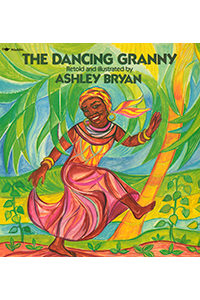
The Dancing Granny (1977)
One of Ashley’s most beloved Afro-Caribbean tales, The Dancing Granny, evokes his own grandmother who loved to dance. In Ashley’s twirling, swirling drawings, the images of trickster Spider Ananse and the Dancing Granny gather and spin across the pages as Ananse tricks Granny Anika out of her vegetables, and Anika tricks Ananse into a whirling, exciting partner dance.“Shake it to the East, Shake it to the West!”
It is difficult to resist both the image and the story of The Dancing Granny!

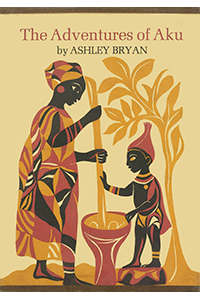
The Adventures of Aku (1976)
A story within a story is like Spider Ananse’s hidden box within a larger box. So, Ashley constructs this African tale about how Cat and Dog, once friends, came to be so different and differently treated. After many adventures, the tale reaches the last box—or, the end—where we learn why Dog sleeps and eats on the ground, while his enemy, Cat, lies on the best mat in the house and eats from a lovely dish.
Ashley’s black and white illustrations and two-color plus black tempura illustrations evoke African wood-block motifs that suggest the ochres and reds of African clay dyes and African textile designs.

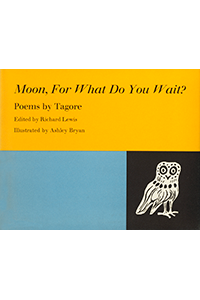
Moon, For What Do You Wait? (illustrator), poems by Rabindranath Tagore, 1967
In 1962, Atheneum Books editor, Jean Karl, first visited his Bronx studio. She was so impressed by his hand-stitched books, inspired by African art, she offered him several contracts—including one to create illustrations for a collection of Bengali poet Rabindradth Tagore’s poems.
This charming little book, with delightful linoleum block prints by Ashley, led to a partnership with his beloved editor, Jean Karl that continued until her death in 2000 and produced thirty more published titles.
Ashley was not satisfied with the way African stories were depicted at the time, and Jean Karl encouraged him to “find your own voice.” Which he has been doing ever since.

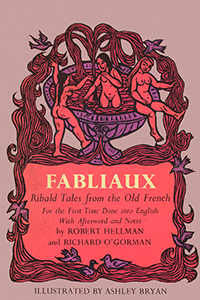
Fabliaux: Ribald Tales from the Old French (illustrator), For the First Time Done into English With Afterword and Notes, by Robert Hellman and Richard O’Gorman (Greenwood Press), 1976, (Apollo, Thomas Y. Crowell Co.), 1965,1966
Fabliaux is a collection of little fables written in thirteenth and fourteenth century France by minstrels, translated by Ashley’s longtime friend, Robert Hellman. This book was the first published work Ashley illustrated in linoleum block illustrations.

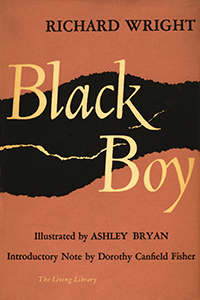
Black Boy (illustrator), by Richard Wright (World Publishing Company), 1950
Ashley did the drawings for Black Boy during his last semester at Cooper Union, after he returned from WWII. This first illustrated edition of Richard Wright’s famous autobiography was published four years later. It is a very obscure edition, and it can only be purchased through rare book stores and sites.





